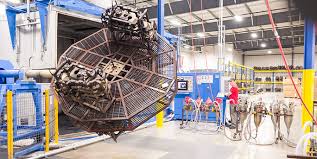Rotational mold, commonly referred to as rotomolding, is an versatile manufacturing process that produces strong, hollow plastic parts. It is especially appreciated due to its ability to make massive, intricate shapes that do not have gaps or weaknesses. This article focuses on the most important aspects of rotating molding as well as its method application, benefits, and drawbacks.
The Rotational Molding Process
Rotational manufacturing involves the heating of plastic material inside a mold which is rotated along two perpendicularly oriented axes. The basic processes are as in the following order:
Loading: The process begins by loading granular or powdered plastic (commonly polyethylene) into the hollow mold. The amount of plastic used is calculated based on what thickness you want the product to have.
Heating The mold is heated in an oven, which causes melting of the mold, and then coat the interior surfaces that make up the mold. When the mold turns it, the plastic is evenly coated inside the cavity of the mold, resulting in an uniform thickness of the wall.
Cooling: After heating, the mold gets cooled while continuing to rotate. The result is that material solidifies evenly, reducing the chance of imperfections like warping, or uneven thickness.
Unloading: Once cooled the mold has been opened, and the finished piece is removed. This process can be repeated to create additional parts as needed.
Applications of Rotational Molding
Rotational molding is extremely versatile and can be utilized in many industries. Common applications include:
Product for the Consumer: Products like play equipment and storage tanks, and coolers are usually made with rotomolding.
Automobile Parts: The components such as fuel tanks and other interior components benefit from the process’s ability to design complicated shapes and lightweight structures.
Industry Equipment Rotational molding is used for producing parts like containers, bins, and structural parts that are large.
Advantages of Rotational Molding
Design Flexibility: The process allows for complex hollow shapes, without need for any additional joints or assembly, which reduces potential weak points.
Uniform Wall Thickness Rotomolding makes parts that have a uniform wall thickness. This enhances strength and durability.
Cost-Effective for Low to Medium Volumes: The cost of tools for rotomolding are less expensive compared to other methods like injection molding, making it affordable for small to medium production runs.
Durability: Parts made with rotational molding are usually resistant to weathering, impact, as well as UV radiation.
Limitations of Rotational Molding
Longer Cycle Time: The heating and cooling cycles of rotomolding are more lengthy compared to processes like injection molding, which could have an impact on the speed of production.
Size Constraints: While molds made by rotomolding can make large parts however, there are limits to the size of the mold as well as its weight, which may influence the maximum dimension of the finished product.
Specific Materials: The range of materials suitable for rotomolding are fewer when compared to other methods restricting the kinds of plastics that can be used.
In the end Plastics Rotomolding is a flexible and economical manufacturing method that can be used to create complex, durable plastic parts. The ability to create hollow, seamless structures makes it a preferred option for many applications, even though it does come with some limitations on cycle times as well as material options.

No Responses